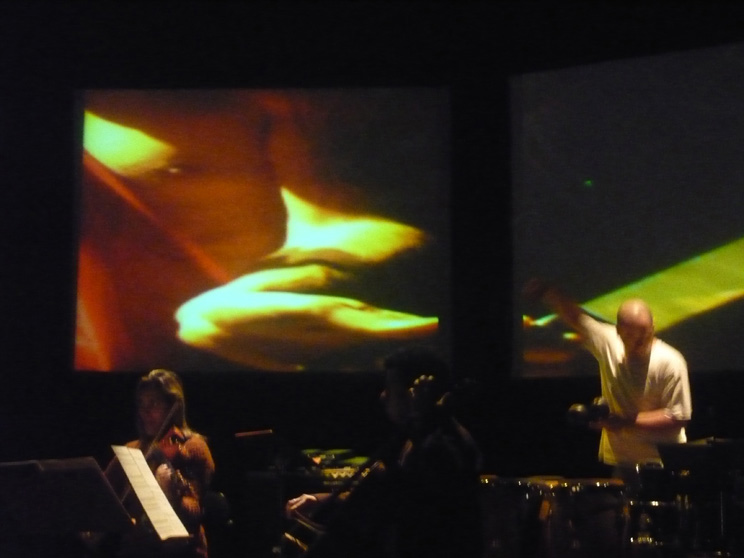
1. the musicality of music and images

Cleusa Sana, Pedro Bielschowsky, Sergio Aluotto, in concert performance of Corpo, Carne e Espirito. Digital imaging featuring Yiorgos Bakalos. All Photos (c) Luca Forcucci
The following writings are notes from the workshop and production experience in Belo Horizonte. They refer primarily to the concert production of Corpo, Carne e Espírito, but I shall at some point also add some commentaries on the experimentations with sound, and the ideas on sound, that surfaced in the Interaktionslabor/workshop during FIT Festival at Francisco Nunes Theatre.
My first thoughts are silent, and have to do with a conversation I had, just prior to arriving in Brasil, with composer Marko Ciciliani. We had listened to his new composition Alias (from a series of works exploring the relationship between music and light), and we had talked about the principles that guide his experiments on composing with light. I then asked him whether he had heard of Thomas Adès, a British composer who recently gained increasing public recognition for his work, and Ciciliani commented on Adès's compositional craftmanship. ("I have a great admiration for his skills: his orchestration is fantastic and his grip on all technical features is immense. Artistically I personally don't find it very interesting but I always find it a pleasure to listen to it, because it's so well done and so musical in a traditional sense. Musicality is a weird thing. I can't really describe what it is. You can't live with it and you can't live without it. It's seductive and therefore often stands in your way".) What is musicality if we think it now in visual terms? is there something we can call "visual music"?
I cannot say anything about Adès as I have not heard his music, my attention was drawn to him after reading a review in the Guardian and after looking at some recent music theatre stagings in Europe and the United States. But I have been listening now for 5 months to the fine musical compositions and complex arrangements created by Paulo Chagas for the collaborative work we were invited to bring to Belo Horizonte. Corpo, Carne e Espírito is a very musical work, written in a complex harmonic and polyphonic style within a 20th century avant-garde tradition of composition (new music, joining acoustic and electronic sound, extended vocal techniques). It also seems to be written within a tradition of the short (chamber music ) form of the oratorio, thus involving vocal roles in a crucial manner. I am in fact curious to build (and provide) a bit of a context for our reflections on musical-visual form, as my collaboration involves the visual scenography (digital live projections) and the staging (stage design, lighting design, visual direction) and thus - traditionally- the more complicated subsidiary role in a concert context which features the musicians (orchestral instrumentalists, singers) who work with the conductor. Moreover, in the case of Corpo, Carne e Espírito, we had agreed that there would be no dancers or actors on stage. Those roles of physical performance would all be integrated into the digital projected environments. I will not speak of digital choreography, as this is again a rather undefined term now sometimes used in the context of 3D graphics design for games or 3D virtual environments (some motion, in these cases, not computer generated but generated from motion-captured movement.action by real actors or dancers). All my video materials and animations created for Corpo were generated with actors: Yiorgos Bakalos, Danielle Black, Michèle Danjoux, Nilüfer Ovalioglu, Johannes Birringer). Some of the images, therefore, can also be called auto-portraits as I used myself as "model" or as dancer. But none of the sequences were created with dance in mind. The visual motifs were painterly. They all deal with photography, painting and arrested motion, to a certain extent, with gesture and the fleshly anatomy of animate bodies, except that in my work for this oratorio all still images and all moving images were created from movement, the human and animal body in motion and under transformation. In a sense, one could speak of painterly animation, created live through the software and digital processing that allows the projectio of images on three screens simultaneously.
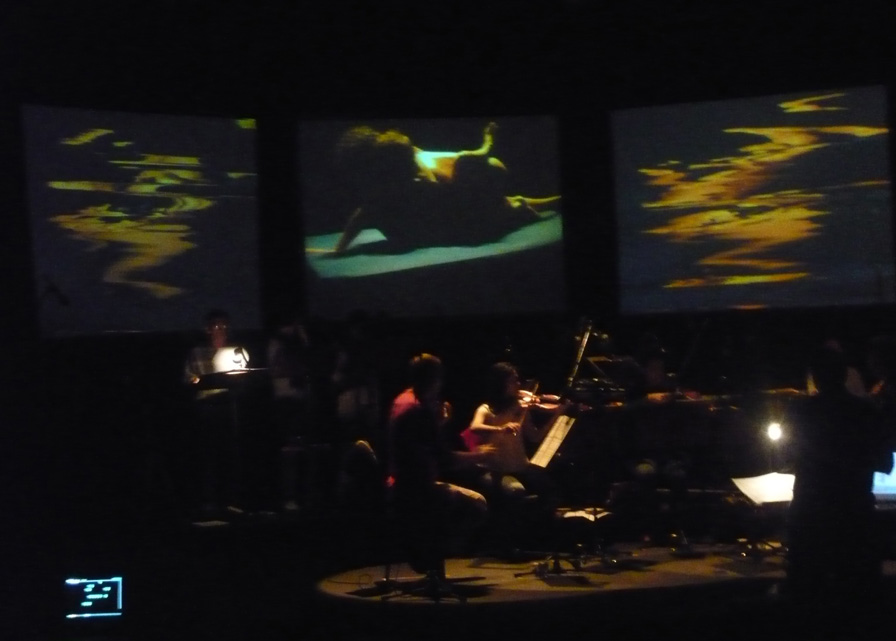
a scene from Arena 17 in the dress rehearsal for Corpo, Carne e Espírito
I am collecting reviews or reports on certain stagings of music works (music theatre works) involving "projections", not necessarily including opera directly but keeping an open eye on contemporary opera stagings as well (especially those in the wake of influential visual compositional techniques following the powerfiul design innovations in Robert Wilson's work or the work of Achim Freyer, for example, but also Meredith Monk's or Laurie Anderson's multimedia stagings, and more recently, Cynthia Hopkins' music dramas such as Accidental Nostalgia). The other context of course is the contemporary digital performance context, which in my case is largely a dance and technology context and an interactive installation art context, and to a much lesser degree the postdramatic theatre spectrum and multimedial stagings you see in the work of The Wooster group or Builders Association or Theatre Complicité. The experience in Belo Horizonte was only my second or third major exposure to the concert stage and working with an orchestra, and that is why I started out with a brief reference to music composition. I also refer you to my discussion of Bela Bartok's Bluebeard's Castle, where I describe the scenographic concept that used video screens and video images on the proscenium removing all musical action from the stage.
Composing for the concert stage cannot be easily aligned with composing for screen media or for live interactive dance concerts. And yet, we live in a culture which is to a very large extent dominated by screen media and the history of film (moving images, video, TV). The role of the projective medium therefore is crucial in our case.
2. visualization, visuals, real-time visual composition, visual spaces of music
I am not sure how to begin to address the deeply problematic relationship between
music and images. After the premiere of Corpo, Carne e Espírito,
I was pleased that it "worked" - (for me as performer), and that it
seemed to have worked for the composer (although he conducted the musicians
and looked mostly at the score during the performance and not at any of the
visual projections); and the musicians enjoyed not only the "cinematic"
side of the concert, but right away, when I first met them in the Palacio das
Artes opera rehearsal room (without us having any screens and projectors yet,
so these were just music rehearsals), I was introduced as the "stage director"
and therefore told them a little about the scene structure as I had understood
it and designed it. I showed them the "visual book." The composition
has 18 "arenas" (and this break-down was my "score" derived
from Paulo Chagas' musical partitura, and I present it here):
Sequence of Screen-Arenas
PART 1
1. BIRTH
Electronic music 4'10"
Color / red canvas on all three screens of triptych.
Abstract figural on red.
Center screen slowly becomes figure (woman bent over). A slow motion of hands,
fists as if in labor, the meaning cannot be determined, but this is a birthing
scene in association. The body of the woman is very faintly seen under the red
cloth on right and left, but not really.
2. PRISON
Electronic music 3'15"
The color changes to a clinical white.
Abstract “shuttering” in the center.
On right a person is becoming slwoly visible under the white (an interrogation
scene, the body squirms on a chair).
On left side, slowly a prison cage appears. There is a still figure inside the
prison. It is a "real" documentary photo. Barely visible. The feeling
is cold, whitewashed walls.
3. MEN’S LOVE
Electronic music 4'55"
Color changes to dark white and grey, and bluish tint.
Two male figures and seen left and right, and then also in middle, a scene of
two men after coitus, exhausted. They lie separate, then together.
There is a harsh sense of love between men, like sport, here. But also full
of anticipation. the sport of love and wrestling.
Entr’acte
Silent Mouth 1 / Scream / disease of the mouth 1:00. Old Man.
PART 2
4. KNIFE / VIOLATION
Soprano, countertenor, baritone, string quartet, percussion and electronic music
8'40"
Red yellow color.
This is single image, slowly breaking into three.
The midde image is man with a knife, and red coat. (anticipating Pope).
Left and right will become images of meat, dangling, hanging. Red, then deformed
to ochre and purple, cut by slicing knife (literally).
5. LONELY / TWO BODIES
Electronic music 3'03"
Return to warm light, and yellowish color circle on floor
The two men again, this time they wrestle in slow motion (Muybridge), erotic
dance of two bodies who come together and fall apart.
6. FILM
Electronic music 3'20"
Abstract green color , slowly intimating nature (plants), blurred
images, a bee, and a moth
The moth transforms into a young female body. Behind green leaves one sees Moraes
portrait, woman on her back, legs up.
Entr’acte
Silent Mouth 2 / Scream 1:00 Young Man.
PART 3
7. EMPTY SPACE
Countertenor, soprano, baritone 2’04“
This scene continues and varies the images of the entr’actes so far. Warped
images of head, and mouth, and scream., young man, older woman. Warm colors
mixed with black and negatuve inversions.
8. SHAVING
String quartet, percussion and electronic music. 4'55"
I mages become white and harsher, the is a blurred mirror in the center, and
behind the mirror we see a luscious female body that is pressed against the
glass (Narcissus), we see also on left and right side of triptych gradually
a slow motion movement of a right shoulder, shadows, arm, and a left shoulder,
shadows, arm.
9. DANCE WITH BLANKET
Cello solo 3'14"
The center is empty at first, but on left side we see a man
with an umbrella , walking away slowly, and on right side we see another man
with umbrella approaching slowly. On velvet ground. Then in the middle there
is a frantic high speed dance solo by a dressed man with a jacket who is doing
in a kind of dervish dance. There is also a ghost of a dervish dance (close
up).
10. MEN’S LOVE BLANKET
Violin, viola, cello, percussion 3'20"
This fast speed is repeated here with unusually distorted dogs
running and also a shadow on floor next to a body and then also ochre color
rising and inside the color is a fluttering purple cloth abstracted animation,
a body without body..
Entr’acte
Silent Mouth 3/ Scream 1:00 Woman.
PART 4
11. LOVE
Soprano and electronic sounds 3’00“
Text: Francis Bacon
The electronic music starts very strongly disclosing a large empty space. The
soprano sings only one word: love.
In this whole part 4 we focus on “portraits", and it begins with
a resonance/echo of the mouth and a few soft erotic images of a bent over man
(men) at extreme diagonal opposite end of the stage, the turned over bodies
moving together as if one, a man entwined with himself (auto-erotic). Moving
between human and animal.
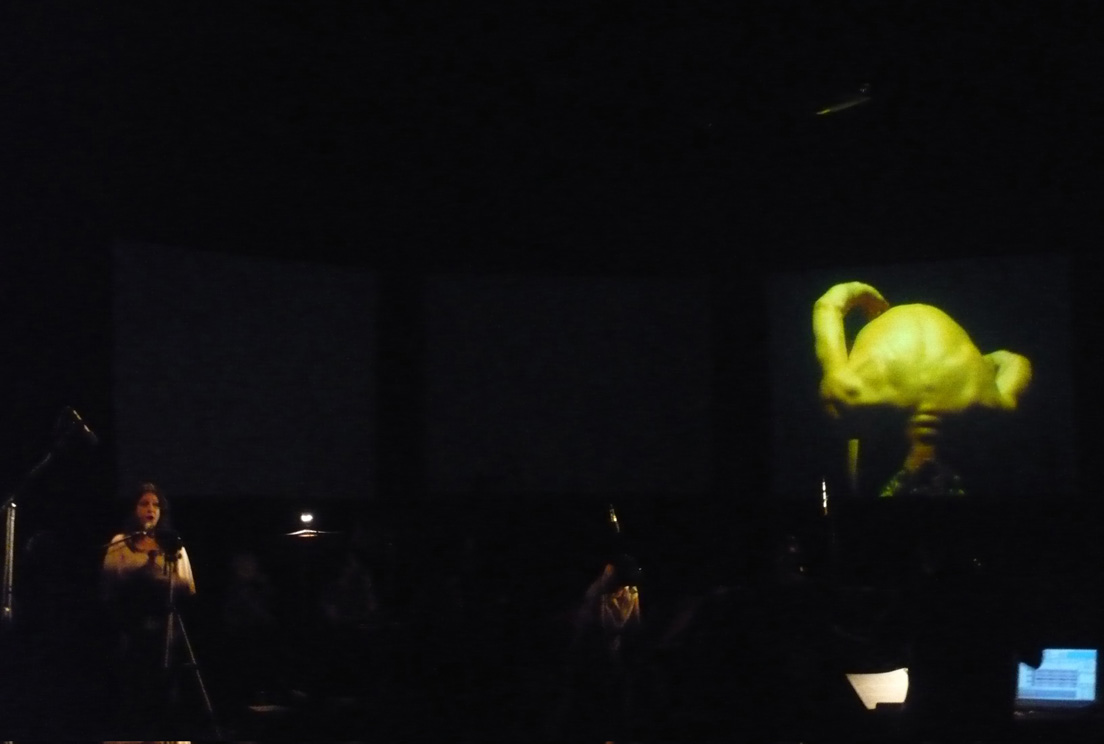
12. POPE
Soprano, countertenor, baritone,
string quartet and percussion 4'04"
A seated figure (man / woman) with a purple cloth and coat, with strange arm
gestures, on either side, as well as in centre. All three popes slow are zoomed
in and freeze in the final instance with mouths wide open. Hands are now invisible,
but they are remembered as claws. .
13. GEORGE DYER
Violin solo 3'00“
Portrait of man in profile, looking to his left, looking to
his right (left and right screen), and in centre there is a full face of a young
woman, Dyer looks at the face in the center which is "handled" by
the bow arm of the violonist, the bow cuts across the face causing the woman
pain, and she responds as if in pleasure. .
14. DISTORTION / SELF-PORTRAIT
String quartet and percussion 4’50“"
This is a very stark scene, horrible to see, a green distorted
face, in severe agony,
Entr’acte
Silent Mouth 4 / Scream 1:00 Young Man/Old Man
PART 5
15. SCOTCH TAPE
Soprano, countertenor, baritone and electronic sounds 2’30“
Text: T. S. Eliot
Relief from the previous scene and the entr’acte
The color change back to warm. And we see a woman lying on her back, left screen
as if waiting to be loved. We also see a man in the same reclined position.
The mood changes from the previous horror to something like exhilarated despair.
An “attendant” appears on the right, a young woman with camera,
filming the scene. After while the attendant becomes a metal pole with surveillance
camera, the same on the opposite side, the surveillance cameras film a bent
over male body in the centre which is waiting to be loved.
16. HANDICAPPED I
Soprano, countertenor and baritone 3’06“
Text: T. S. Eliot
Change to red color. We see refractions of the meat and young body, but now
more erotic (Moraes lying on back) and more tuned to a spiritual yearning that
comes through the voices. We see more outdoor images of abstract motion.
17. HANDICAPPED 2
String quartet and percussion 3'20
Abstract and figural images.
The male bodies of the wrestler re-appear. Two figures in room. The face of
a woman appears. The bodies on left and right become deaniomated and digitally
anamorphosed, through a scanner that cuts the body horizontally in ever progressing
layers.
18. HANDICAPPED 3
Soprano, countertenor, baritone, string quartet and percussion 2’40“
Text: Francis Bacon
Abstract and figural images (a face melting with honey, another feslh body digitally
anamorphosed)
A red scene with abstract moving squares begins to appear, boxes or framings
that enclose the disappearing bodies.
Total time: 72:28 min
* * *
In fact, when I started to work on the story boards for the film shoots in the spring of 2008, I was started out making my own structural design (thematic motifs) and my drawings, rather than focussing on the music how I could hear it (.i.e. the composition) and translate it, especially the scenes involving the vocalists. Later it seemed easier to follow the score directly, choosing images related to the voice sand instrumentation. I had wanted to avoid what Bacon always diskliked in painting as such, namely "illustration." I studied the sources (the paintings of Francis Bacon) and what he refered to as the "brutality of fact." The visual sources eventually took over, they captured all my attention. I began to make a visual book based on my ideas and reactions to Bacon's paintings and what he considers painting's uncanny ability to come across "directly into the nervous system" (David Sylvester, ed., Interviews with Francis Bacon, New York: Thames & Hudosn, 1987, p. 18).
.
At a later point, deciding on the silent "entr'actes" (1 minute silent
movies, I call them), we basically wanted these to be brief silent scenes
where one of the singers goes downstage right to a live camera and mic, and
does a silent improvisation of singing without singing or listening to their
inner voice moving the face, jaws, mouth wide open, as in the "scream"
studies that Bacon painted which were not about the scream as such, but about
the head and how the human head changes when it opens up in a close up to become
a hole or an "Abgrund".........).
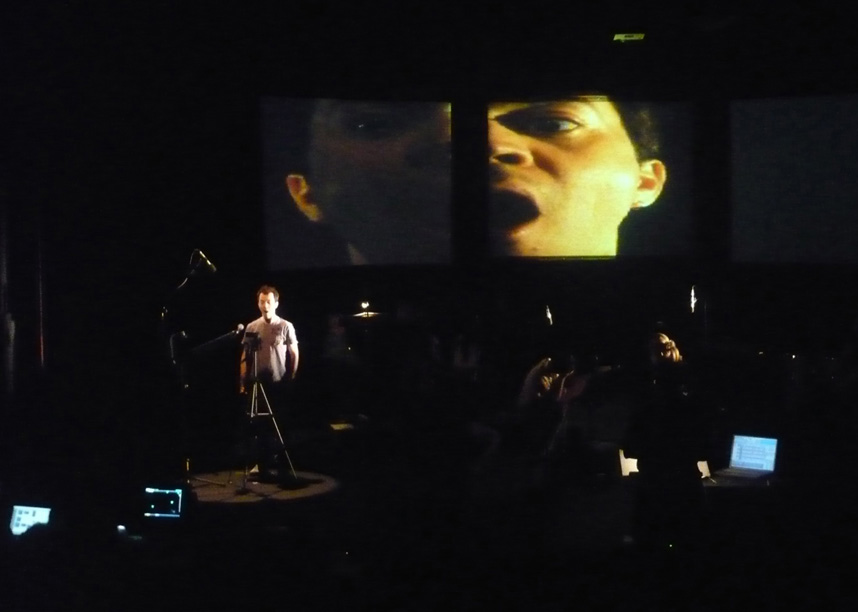
Sérgio Anders in the second Entr-acte
I basically decided to follow a pattern (baritone, counter tenor, soprano; then both the men – baritone & countertenor – in a silent duet) that seemed logical following the scene score for the voices. I should have read the scores for the voices, and who sings what at which point, and whether alone (solo) or in trio or duet. The soprano, for example, comes on in Entr'acte 3, and I asked her to do a more restrained action with her face and eyes, less with the mouth, and then she stays in that spotlight downstage right to sing an aria in the following scene accompanied by electronic music, and it is a very beautiful and haunting aria, and I use only one screen (upstage left) in diagonal opposition.
What you see is an upturned body or spine. The more I now look at the overall "composition" of my visual projections to/with the voices and the solo instruments, I see the spatiality of the images/imaging – we decided in the last week of rehearsals to give the lead violin and the violincello solos, when they occur, a separate "space" so to speak, meaning, the violonist gets up and stands on the same spotlight downstage right as the vocalists, and I can capture and manipulate his left hand (the hand that holds/plays the tones on the strings not the bow hand) from the camera feed. ..... the cello we placed downstage left, that was more cumbersome, he has to put his cello end (the spike) into a wooden holder, sit down, put his score out on the music stand.........
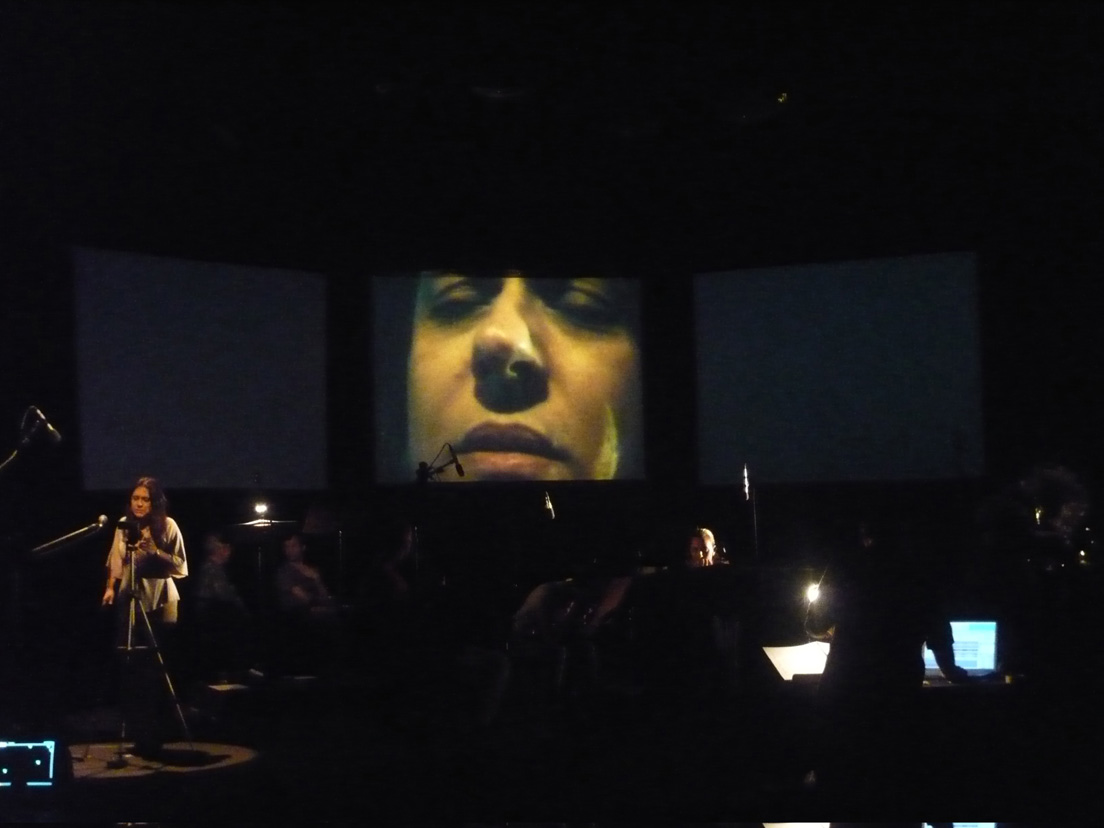 .
.
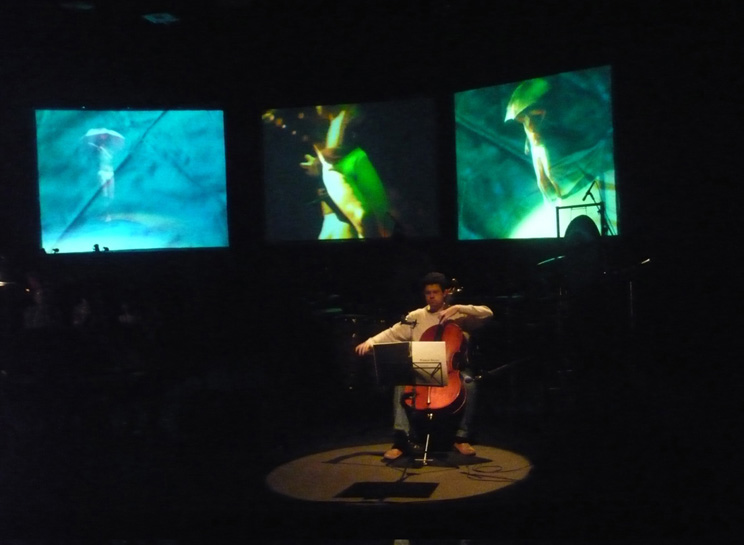
Mônica Pedrosa in Entr'acte 3; Pedro Bielschowsky in violincello solo in scene 9.
I watched the percussionist for hours. Sergio Aluotto worked the hardest, extremely
busy preparing himself and his space of performance. I watched how he cut up
the score, and placed the pieces around, on several music stands, behind/next
to the marimba, the cymbals, the drums, the gong, the many percussive instruments
he has. He rehearsed for hours, learning everything more or less by heart. He
has all these "tools", then he measured the precise distances between
all instruments, their positions, and learnt the physical movements, so this
is a choreogrpahy for his percussive solos, where he needs to know exactly where
everything is to hit it right (when we hung the lights, I had to get above him
with the ladder, to focus some color gels above him (yellow and green I used,
and a tiny bit of magenta). When I asked- in the same process -to move all percussion
instruments 60 cm to stage left,. well, it was quite an operation, it took him
hours to re-place everything very precisely.
I had no idea about some of these particularities of the instrumental performance,
and am fascinated.of course by the physical side of the concert performance,
which surely comes as no suprise to those who work in music all the time. I
come back to my initial point: I learn to think of the images now in relation
to what I hear in the vocal music, and what I sense in the complex physical
interactions of the string quartet and percussion sections (there are repetitions,
and variations of certain motifs and there are patterns that I now recognize;
the music is not rhythmic really, with a lot of dynamic changes, but it obviously
has different tempi. I hear classical avant-garde disharmonics, and quasi-atonalities.
I discern patterns, and echoes/repetitions. The electronic parts are dense,
I like them a lot, and they constitute the entire opening act (3 scenes), played
in the dark.
3. Lighting in projective filmic environments
The role of lighting is critical, without doubt, and we paid much attention to it in the workshop on interactive performance, since any use of video projections and live cameras requires careful configurations of the stage space. To a certain extent, one wants to feature the digital projections, but not at the expense of the physical performance of the musicians. The musicians, on the other hand, need to see their scores. I lit: (1) string quartet 8 lamps, two on each, (2) conductor light, (3) violin solo/camera and violincello spot (3 lamps each), mostly down light and slight front light, the silent movie actors also get side lights).(4) the percussion area, 8 lights. 4 white & 4 color, all others only white, except (5) 6 lights on vocalists in a diagonal with two on each, one white and one color.
We kept most of the lights for instrumentalists at 50 or 55 percept, to allow
for enough darkness for the film projections.The conductor spot was dimmed (or
off completely, as Paulo said it threw a shadow on his score – we had
to use front light due to gridding), and he ended up mostly using his clip light
(bad for me doing the living interactive digital mixing, seated downstage right
in the auditorium near the stage apron: I cannot see his hands when he cues
me). He also cues the lighting operator back in the house for each start of
a new scene. Paulo also cues the vocalists to step forward to the camera 35
seconds prior to end of scene while music still plays. Paulo used a click track
device (he bought it in LA for his right ear, it is worn like a half-head set)
for keeping the pacing, and I did not realize that my own (soft) clicking of
the mouse when I live code Isadora was audible to him and distracting.... Iswitched
to touch pad when I noted his discomfort, as I am only 4 meters away to his
left.
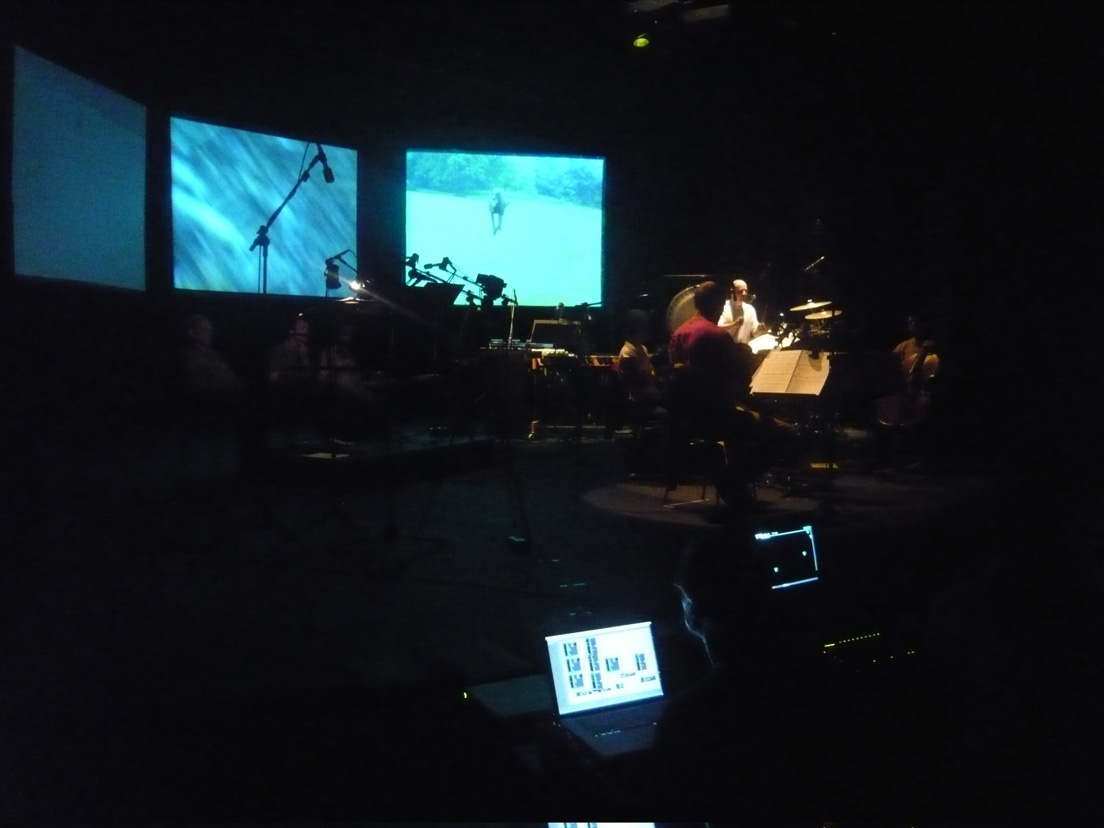
Johannes Birringer downstage right in front of the orchestra.
These technical considerations, the cabling, all the amplifications for each instrumentalist and vocalist, were quite extensive, and they impact the stage space and the scenic space as whole, to a very large extent. The stage is full. I must say, when all clip lights are on (music stands), it sometimes tends to get too bright or klunky on stage. I would like the instrumentalists to know their scores by heart but that is unrealistic.
Now back to my question: I am going to investigate the meanings and the perceptions now gained from the compositional structure, the scenographic/ligthing "plots" or programs, the live visual image mixing programming that performs with the music. Can the visual paintings sustain themselves and be heard without illustrating the emotional organisation of time achieved the music? Can the triptych projections enhance the nature of the (music) concert or can the visuals generate associations not achievable through the largely abstract quality of the music, even if one may not be able to speak of abstract music when vocal dramatic singing is involved? Is is perhaps a misconception to think of music as abstract in the first place? If musicis the organization of emotions in time, as I once heard a composer call it, can such organization be countered or subtly supported by the visual projections?
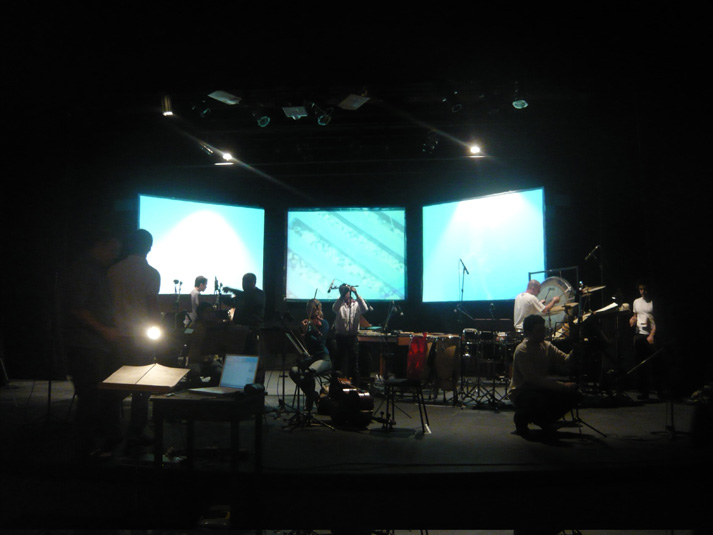
Setting up all amplifications, mics and cables for the orchestra in front of triptych projection screens.
One could speculate that each musicality, each music, as Ciciliani writes in
reponse to his sense of what Adès writes, each genre, each rhythmicality,
each intensity (high versus low, shrill /heavy metal versus soft ambient, dynamic
power drive as in Rite of Spring/Stravinsky or Shostakovic compared to mellifluous
Arvo Pärt,. Debussy, Kurt Weill, Steve Reich, Philip Glass, well, one could
ask what do you see when you listen to these musics? when you listen to Stockhausen
or Wilco, or Lenin (a band from Brasil), and their polyrhythms or changes in
rhythms and melodic structures,. or say, if you sample the sound tracks of games
(Grand Auto Theft III, Halo IV) or of manga films, what do the musics conjure
up in our visual mind or brain?
4. video/digital aesthetics
When you work thematically, say, in the manner I did for CORPO, all images have
a certain aesthetic, or follow a thematic line. Thus the asthetic style as such
organizes the kind of imaging that is becoming visisble and that is felt as
its own visual rhythm and flow. How would I comment on my aesthetic for the
visual choices?
1) body based performance films.
(a mix between Bruce Nauman – carrying out a task in his studio and filming
it, such as, walk from the back of room in slightly stilted manner with umbrella
behind your back held in left arm, and right arm twisted outward as if trying
to catch a few raindrops - and Pina Bausch – ask the dancers a question
[what did it feel like to give birth to your daughter?][what do you do when
you sit alone in a room for hours, how do you sit on a chair for hours? can
you show me?] and see what they come up with....).
2) body based dance (a butoh like slow sequence of a twisted and gnarled body)
3) Muybridge studies of male bodies wrestling [or a man walking up or down stairs
or an athlete throwing an imaginary javelin] , using the idea of stop motion
photographjy/chronophotography
4) taking the "Muybridge" studies as inspiration for animation and
creating small films with stop motion / still images
5) use "accident" as Bacon often did when he smeared a patch on canvas
and wiped it or repainted it, to see what had happened to a part of a body without
that he knew how it happened, and a head became a buttock or a breast merged
with thigh, or a face now had three eyes. My accident happened with the dog
shoot in the park, and then the dance of the man with jacket: the Panasonic
camera broke and continued filming at an accelerated frame rate missing whole
bunches of frames and "slicing" the film strip, so to speak. The film
ended up looking hacked, in a fantastic way, the dog ran at the camera as it
could have never been edited. Most erotic or nude protraits were filmed in real
time but action was slow and deliberate. The film shoots took place in black
box under variable ligthing. One shoot used heavy red lighting, one used pale
blues, one used strong greens and yellows.
6. Film of textures and color (different cloth in red, pink, ochre, and yellow or velvet, purple, and whites, to get to the "grounds" of Bacon's color filelds). I wanted to always have a color tone. This didn't fully succeed, and I noted that mixing textured colors/cloths with performance tends to make the images occasionally look duller, or muffled which is the software's fault.
7. I made (edited) about 110 short films. They vary in length from 5 seconds
to 2: 15'; they are potentially to be used in loop form or modified time (slowed
down, sped up).
8. The aesthetic of visual stream (shall we call the triple projection – projected light? projective images, cinematographies, real-time streams?). What are images that are "outputted" from a real time rendering or filtering/mixing software program such as Isadora? (Isadora uses all the samples from the media data, moving images and still images, plus the live video feeds).
The aesthetic of streaming in CORPO was such that over the duration of the concert the audience gets to know the "style" or the form of the images. Not quick MTV or slick super dymamic digital effects, nor thriller video or Blair Witch/Cloverfield hand held trash video style, nor transcendentalist landscapes or slow motion bodies as in Bill Viola's diving and drowning men, no wide angle or still moving Tarkovsky landscapes, no Italian neorealism in black and white (Antonioni), no hyper-extreme slowdown distortions of the kind Douglas Gordon or Pierre Huyghe have tried in video art, no Steve McQueen puzzles with black intervals and fuzzy gaps and extreme angles shooting up your body into the sky.
And yet, my images are either theatrical performance photography (against black background, the flesh body catches the light and is illuminated, it resonates warmly, it glows). using a distinct focus on the body in the frame. Or they are more abstracted outdoor images, of ground, fauna, sculptural elements and materials, stone, metal, hard versus organic surfaces, and all cloth textures have creases and invoke the folds of flesh. Most of them are carefully filmed hand-held, so indeed there is a certain kinetic tension in all images as they
(1) are captured in breathing and in hand-held physical motion, sometimes they
slightly tremble, they are never "fully composed" and steady (steady
cam);
(2) are always played (output) in a slowed down time (percentage from 100% to
1), which varies and which I change all the time during performannce;
(3) are often filtered through digital effects such as tracings, blurs, distortions,
spectral inversions, wipe and scan cycles, color shifts, color changes, etc
(4) are sequential. The film images on the triptych can be: all the same (never
played at same time/tempo), – all different, – or combinations 1
plus 2 the same, with side by side or left right center juxtapositions, 1 alone
2 alone, etc. all variations;
5) can appear arrested in motion: I sometimes slow down the motion and stop
it altogether, as in the scream scenes (scene 12: Pope) when I halt the slow
zoom of the camera movement, then release halt, and halt again (the latter scene
allows me to create in real time, at a particular moment in the scenario, the
strange emotional effect generated in Chris Marker's "La Jetée"
which uses still frames only but has one singular scene of the woman's face
when the still image suddenly comes alive for a few seconds and we see the eyelids
blink).
* * *
5. painting with real-time interactive video
One can now look at this aesthetic palette (and one might ask oneself what kind
of light aesthetic or color aesthetic is used in particular cases of pure projected
light or projected laser beams (lines? fields? blotches, jigzags) and what it
generates, in the case of Ciciliani's work or the light
fields used in the CORPO production) and ask how do we describe this aesthetic?
When people asked me after the concert, I spoke of it as painterly. I suggested
I was painting with video in real time.
Then I feel suddenly that we have a dearth of adequate vocabularies. Has this been exlored in video art aesthetics? Why are there no writings on projection aesthetics in live peformance?
Projection (light) art, how is it described in aesthetic or symbolic terms?
The early modernist work? the later work after op art and kinetic art of the
60s, what do we find for light art and foms of projection, is there a recognizable
vocabulary that has been described, for example, for Ryoji
Ikeda's work? (if for a moment we think of established film criticism, Christian
Metz, Roland Barthes, Bellour, Stephen Heath, Brody, Peter Wollen, and other
studies by feminists such as Laura Mulvey, Teresa de Lauretis, Kaja Silverman,
etc), or more eccentric books like Deleuze on the "movement image"
and the "time image" (Deleuze is quoted vigorously in the October
issue I mention below, and of course Paulo Chagas brought Glles Deleuze's complex
book on Francis Bacon to my attention: The Logic of Sensation, trans.
Daniel W. Smith, Mionneapolis: Univ. of Minnesota Press, 2002). The only writing
by a composer on visuals that I can remember is an essay by Joel Ryan, "Music
Visualization," in Making Art of Databases,. ed. Joke Brouwer, Arjen Mulder,
Susan Charlton Rotterdam: V2_Publishing/NAi Publishers, 2003, pp. 56-69.
On the flight back from Brasil I did read with great interest OCTOBER # 113,
the issue of the journal dedicated to video art. It describes the aesthetics
of Michael Snow, and also of Steve McQueen, and the initial essays are on Buster
Keaton and the "burlesque body" in the silent movie era and the kinetics
of that particular silent era comedy where the body seems to struggle with space
or against spatiality. And then a link is made between what film and dance critics
noted for the early stages of cinematography, namely correspondences of motion
to motion picture technology, resonances that are important for the machine
age and automation, and those "automated" Fordist bodies and chorus
lines that also were scrutinized by Kracauer in his theories of the "ornament"
(Tiller Girls, etc). The best historical study of these phenomena is Felicia
McCarren, Dancing Machines: Choreographies of the Age of Mechanical Reproduction,
Stanford: Stanford UP, 2003.(1)
---
I admit I am intrigued by the burlesque body, the "slapsticked" body,
the clown body that falls and makes you laugh at the human pratfalls, something
I have rarely been able to achieve in my dance work, people don't laugh, and
it was the same in Belo Horizonte, I don't think there was much laughter in
the house......But think of "animation" and what we see in the "ediiting"
of motion (when sped up or slowed down)– is it not a slapstick effect?
Is not what I do in Isadora software a re-kineticization of the image to slapstick
the body or overextend (dilate) it? Make it strange?
"Dilated" is one term that I did read, a long while ago, in the context
of theatre theory, and it comes from Eugenio Barba's writings on physical theatre
and the extreme actor. He uses the term "the dilated body" - and I
like this term a lot although I do not fully know how the physical torque, which
is also described very poignantly in Hillel Schwartz's long essay on the modern
"kineasthetic", can be easily translated (in a phenomenological sense)
to the imaged body and imaged body distortions we achieve via manipulation of
data, of mathematical numbers. It would help us to locate some theoretical or
philosophical framework of terms that allow the interpretation of visualization
as it relates to the physical movement and as it relates to the musical movement.
Theoretically, the issues are even more complex if we look at projection in
the theatre, since it is not commonly assumed that projected light or color
in the theatre functions as it might in a visual arts context. Regarding Ciciliani's
work, seeing light pulsations along with hearing music pulses (and seeing the
physical performance of a violinist using a bow and thus allowing us perceptions
of bow movement against./as light movement or movement lines, how do we describe
the visual or distinguish the visuality from the musicality? are they emotionally
conjoined? do our brains synaesthetically read them together? The lighting in
Ciciliani's work is green, most of the time (in one performance there was red
and pink used, and in another there was blue). The strong primary colors, do
they affect us differently? And what about dirtied light? or strobed/stroboscopic
light. Can projecting light be dilated or dilate the body inside the light?
Can light be bent or is our perception creating illusions of light movement
within a space where it is bound or bounces?
In Buster Keaton terms, can light be slapstick? At the end of the Belo Horizonte
workshop on interactive technologies, I showed Movemernt
A (the performance work by Ulf Langheinrich and Toshiko Oiwa) from
their 2007 Dresden/Hellerau performance (CYNETart Festival 2007). When I showed
the slides I had and told them about this movement / video projection work,
the audience requested to see the whole performance film of Movement A,
and I showed it on the last day and there was a stunned silence afterwards,
especially after the powerful onslaught of the last 20 minutes of strobe light
intermingled with the percolating video pixels. People were visibly moved and
distressed afterwards. The projection, in this case, dismantles the
psyche. Movement A is a poetic-existentialist work, not slapstick,
of course. (Please see my blog on the CYNETart festival and commentary
on Movement A).
When Edison, and Eisenstein and Vertov, the Russian constructivists, the German
expressionist early filmmakers experimented with projection, what did we glimpse
from the early avant-garde concepts of image-movement? Abel Gance's first ever
"splitting" of the screen into three screens (Napoleon, 1927),
much later redisovered in Timecode by Mike Figgis (2000) How do we
compare narrative and non-narrative approaches to visual projection, and in
what tradition, for example, can Peneleope Wehrli's video scenography be placed?
Does it beong to the visual arts traditions, and what of the makers of the first
"Entr'acte" ? – a 1924 short film directed by René Clair,
premiered as entr'acte for the Ballets Suédois production Relâche
at the Théâtre des Champs-Élysées in Paris. Relâche
was based on a book and with settings by Francis Picabia; choreography by Jean
Borlin; the music for both the ballet and the film was composed by Erik Satie.
Dance has played a role in the kinetics of film from the very beginning. What
does dada and surrealism teach us about the cinematographic body?
I am now reading Ann Cooper Albright's new book Traces of Light. I am interested of course in the research on Loïe Fuller's choreography and her choreography of light, her innovative use of projected light under/behind and on top of her elaborate garments. She pioneered "underlighting" and became famous for her "electric dances." The last chapter of the book is called "Resurrecting the Future: Body, Image and Technology," and here the author specifically describes Fuller's inventions of dances with/for electric light (and compares it to the digital dance Ghostcatching created by Shelley Eshkar and Paul Kaiser). Apparently she got a patent for a dance called "L'Archange", and as with her "garments for dance" she used special light effects for her choreography. What Albright describes quite nicely, and also re-creates in her practice – is the L'Archange concept, of "underlighting" – this is fascinating. The dancer performed on a platform made of glass, and some lighting instruments were underneath the floor pointed upwards inside the moving body. I am thinking of Ciciliani's new Alchemy piece here, Rational Cantilenae in Nine Triads, for piano, vocal utterings and lighting, which seems to also use a form of under-lighting. In his conceptual notes, Ciciliani mentions that the "rhythmic organisation of the music, as well as the lighting, is derived from proportions within triads. The triad is used because it is a heavily charged symbol in Alchemy. This piece also contains sections where the music is silent and where the light forms the only active element. When composing these sections, I organised the light according to rhythmic and spatial principles. In doing so I used parameters that are also characteristic of sonic material. My goal was that this would give the light a musical quality that organically connects with the sonic elements."
Now we return to Eurydike and Adès, for a moment. In the further explorations
of the subject of this workshop, I will construct some theory/contextual pages
of writing on this website for Interaktionslabor VI, also in preparation for
Interaktionslabor VII, which will be dedicated to further research in music
and technology.
Liquid Penguin
Eurydike hinter den Grenzen
Orphée n’a t-il pas, par son chant, transgressé les frontières
de la mort pour retrouver sa bien-aimée – qu’il se retourne
intempestivement et réduit tout à
néant : elle lui est de nouveau arrachée et depuis, la plainte
d’Orphée (dans l’opéra) n’a de cesse de se faire
entendre. Mais ce qu’il ne soupçonne pas, c’est
qu’Eurydice, ne pleure pas très longtemps sa perte. Elle a déjà
entrepris d’explorer le Royaume des Morts… Dans leurs mondes artistiques
différents – opéra baroque, nouvelle musique, improvisation
et performance – les deux ensembles pazzaCaglia et Liquid Penguin explorent
ce mythe ancestral à la recherche de nouvelles lectures : les ténèbres
et l’inconnu seraient-ils peut être autre que ce que nous imaginons
? Et ce que nous désirons le plus ardemment ne serait-il pas différent
de ce que nous
attendons ?
What do we imagine when we listen?
As I mention in my review of Bluebeard's Castle, the vocalist/actress Katharina Bihler (of Liquid Penguin) performed as a guest in the Bartók opera production at Saarbruecken. Bluebeard's Castle featured the two singers of Bartok's piece on the extended front apron, in the first row of the audience. Featured on stage: video screens and video projections, static and turning, by the German designer Penelope Wehrli. I was fascinated by this idea of giving the stage over to a video artist to "design" the movement of the contents (sung/interpreted vocally by the singers), but with practically no stage action. The "dramatization" of the director's concept was such that on the front apron the Duke comes in and lies down on the couch: Bluebeard is psychopath/client, and Judith then arrives as psychotherapist, and she makes him (and herself) re-call/remember all the horrible things.
The designer throws the video images onto the stage, with many turning and spinning screens and mirror screens & multiple projections. One could call them video objects, they did not have much of a phenomenologoacl presence or physcial impact, which weakened their power or made them indeed overly illustrative. I will "contexture" my notes on this staging (and Wehrli continues to work in this mode, see her latest Orpheus amorph_, pointing out that another recent staging at Radialsystem in Berlin, back in February 2008, used a triptych screen projection for a concert which featured orchestra and choir: Here the context was "sacred" music, so to speak, Ernst Peppings Passionsbericht des Matthäus (1949), directed by scenographer Hans-Werner Kroesinger. When I saw the press photo. I was struck by the "overhead" placement of the altar-like triptychon.
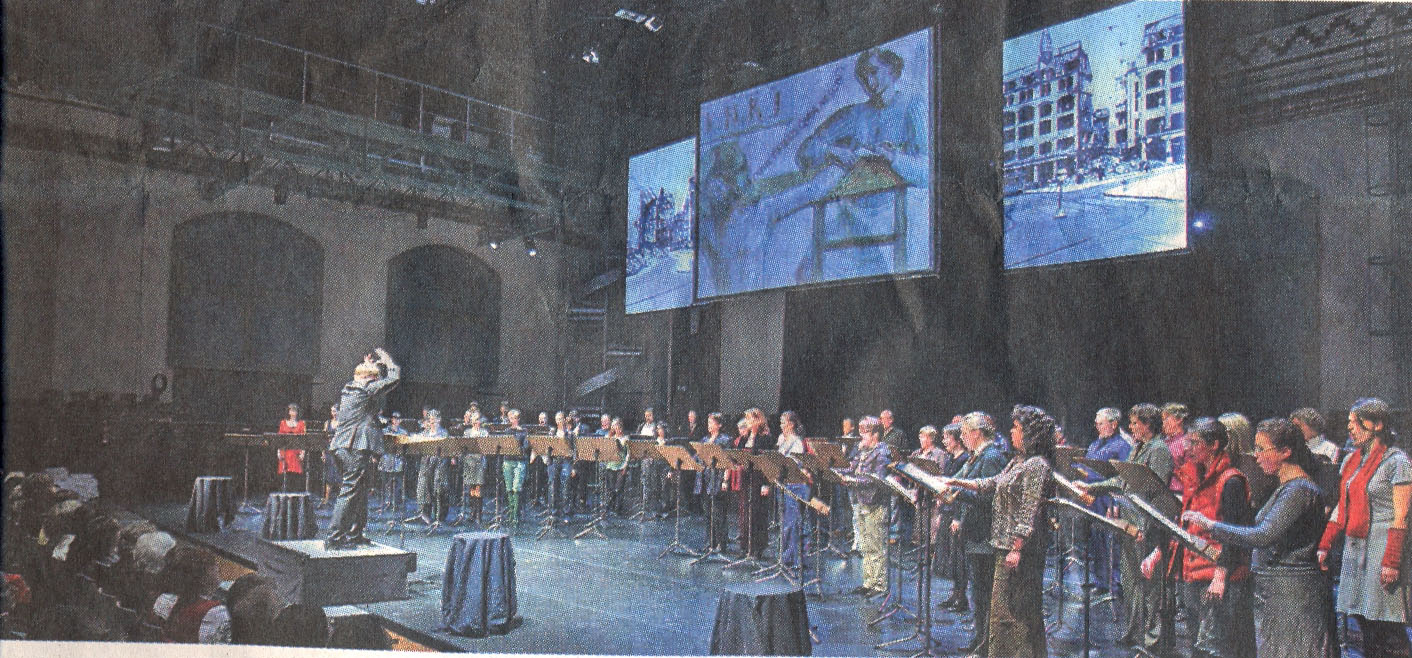
Passionsbericht des Matthäus, Radialsystem Berlin, 2008.
What does Adès have to say about the relation of music to visuals? (I
would like to find images of his production of In
Seven Days
(Piano Concerto with Moving Image)--- his collaborator was video artist
Tal Rosner. (2)
In the Guardian article (July 5, 2008), I find the following paragraph (it comes right after a strange biographical anecdote, reporting that young Thomas Adès was supposed to meet his art historian mother at a restaurant in South Kensington, and when he finds her, there she sits at the dinner table with Francis Bacon; Thomas recites TS Eliot to the painter who likes the boy):
"The American music critic Richard Taruskin made much of the influence of art on Adès. He describes the work as "painterly" rather than narrative in the way it achieves atmosphere and meaning through 'outlandish juxtapositions of evocative sound-objects that hover, shimmering, or dreamily revolve, in a seemingly motionless sonic emulsion. I know of no other music quite like it in these defining respects,' wrote Taruskin, 'but many paintings by Dali, De Chirico, Magritte. Mr Adès himself seems to 'see' his music rather than hear it..... He was recently in Los Angeles where he and Tal Rosner's multimedia piano concerto, In Seven Days, was performed. He was delighted that 'it just didn't occur to anyone there to comment on the fact that there are some pictures to look at while you're listening to music....'"
That last reference sounds like a throw away, in an artiicle on a "serious"
composer. But what if we follow this through a bit more. What if indeed (as
certainly the case in Belo Horizonte) it were still an issue, and audiences
can get confounded, when there are pictures to look at. or when there is a certain
music to listen to while one could enjoy the pictures. Much of the critical
press echo in Belo Horizonte dwelled on the fact that audiences could not "place"
Corpo, Carne e Espírito in a theatre context, and were confounded
as they may have expected actors and action. The interactive live programming
did not seem to have registered at all, to audiences not familiar with interactive
digital art or live coding (see Marcello Castilho Avellar , "FIT
traz provocação com Corpo, carne e espírito",
Estado de Minas, 30 June 2008).(3)
Kandisnky's Der Gelbe Klang. What did it sound like? What did it look like? (Kandinskry probably liked mysticism and prefered abstraction, unlike Schlemmer who loved design and abstract architecture but obviously built precise figurines and figures for his Bauhaus dances: design in motion). And what about Achim Freyer's own work? Freyer is a painter and stage designer, has worked extensivley in opera where he became known for his visual stagings of Philip Glass's operas in Germany. He also created his own visual performances; in Kassel at one of the documentas (1987), he performed a piece with 12 students dressed in black. One could barely see them, they were completed hidden by black dress and masks. They carried around 1.50m long fluorescent lighting slabs. They performed – on a severely raked stage – a series of combinations (reflections / meditations) on Kandinksy's theory of line, point, plane [working in two dimensions on a three dimensional stage which uses certain perspective to play with illusion of depth. But also with flatness, and trompe l'oeil? What are the productive contradictions here? What is the meaning of the line (of light), and the geometries you can create with lines (triangles, squares, cubes)?]
Kandinsky's Point and Line to Plane (1926) contained a portion of his
course material. The point, according to Kandinsky, is the proto-element of
painting, its antithesis is the line. The point means rest, the line creates
tension by movement. The boundary between the line and the plane is indefinite
and mobile, but "even the straight line... carries within it with its other
characteristics the desire... to give birth to a plane".
Birringer's imaging of arena 4, Knife/Violation, Corpo, Carne e Espirito.
I will come back to the geometrics at another occasion; for our production of Corpo, Carne e Espírito, geometry was not the issue, but bodies and bodily distortions of flesh and mind, dilated bodies in erotic zones of indeterminacy. The visual content that guided my work for the production was the body close up captured by the camera in slow motion - this slow space of bodies I wanted to project into the music, so to speak without judging the music, without staying too close to Bacon's paintings and yet close enough, without juxtposiing anything to the music, without expressing anything of the music. And yet, my images express and the actors used expression, some more than others naturally, and my direction for their actions were not based on motivations (as in Stanislavski or Method acting) but on viewpoints and points in motion, following through a task of an action that can be followed. For the singers I did use motivation based on visual images, asking them to imagine their mouths opening and closing, as if they were telling us a joke or a listening to something whispered into their ear, insidious or hilarious comments on fragilities of bodies which we are, flesh worn down, flesh aroused, flesh feeble and flesh muscular, entwined to our sense of self or sense of what is.
The visual movement is deferred (enacted) painting, as if the camera is a brush and the stroke. The flesh is always drawn to the mirror which sees it. In Corpo, the projection is frontal but can also be splayed, smeared over the edges of frame, box, prison, bed, and the movement is focussed on closeness (proximity) and depth, never on lateral motion or sliding/panning, as it can be done to evoke spatial movement (from left to right, right to left). The images have a certain anatomical resonance, and in terms of "action" they would be closer to the 3D POV motion of a camera in a game environment. The ego shooter moves slowly into the room, to shoot and be shot dead, the avatar body ends up lying contorted on the floor. We always do that, don't we, we step into the rooms and into the beds where we will die and where we will love. Yet Corpo is not a game, it is an emotional tapestry of many different repositionings of the human (and animal) body in front of the lens and the scalpel. The bodies in the visual world of Corpo are positioned to be viewed as portraits, born astride a grave or what is also called the prisonhouse of love.
Notes:
(1) See also: Laurent Mannoni, The Great Art of Light and Shadow: Archaeology of the Cinema, trans. Richard Crangle, Exeter: University of Exeter Press, 2000; Hillel Schwartz, "Torque: The New Kinesthetic of the Twentieth Century," ZONE 6 (Incorporations), ed. Jonathan Crary and Sanford Kwintner. Cambridge, Mass.: MIT Press, 1992, pp 71-127; Ann Cooper Albright, Traces of Light: Absence and Presence in the Work of Loïe Fuller, Middletown: Wesleyan University Press, 2007; Susan Kozel, Closer: Performance, Technologies, Phenomenology, Cambridge: MIT Press, 2008; and Anna Munster, Materializing New Media: Embodiment in Information Aesthetics. Dartmouth College Press, University of New England, 2006.
(2) Tal Rosner website includes a 3 minute video which is intereting in regard to rhythmic correspondences or juxtapositions to rock music (P J Harvey). The issue with music videos or visualized songs, of course is that the visualization can be poetic or suggestive, or it can be rather literal. and display redundancies, as suggested in my soft critique of the the overuse of documentary and TV/film-movie archive images in Wehrli's Blaubart. In Rosner's case, the staggered rhythm grows on our visual perception after a while, and one can speculate on how visuals sustain or generate their own rhythm or appear to be rhythmic to/with the music and what rhythmic correspondence does to our imagination (one also remembers the odd flow of incessant imagery in Godfrey Reggio's Koyaanisqatsi edited to the minimalist score by Philip Glass).
(3) For Luiz Carlos Garrocho's website blog on the workshop
and critical ideas on "Performance e Tecnologia", go here.
For his commentaries on the workshop, see (1)
Textualidades
Cênicas Contemporâneas ; (2) Os
Novos Jogos da Performance ; and (3)
Paisagens
Sonoras Imaginárias
________
Texte und Kommentare zum Labor 2008 werden hier veröffentlicht
Texts and commentaries on the 2008 lab and related research subjects will be published here.